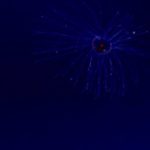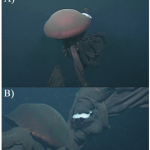On May 9th of 2012, I wrote about a video going viral of an odd creature in the deep sea. The running hypothesis among online communities is was it was a whale placenta. It was not, more interesting it was the rather enimagic Deepstaria reticulum, one of the most spectacular jellyfish at the time. At the of the video, I confirmed with jellyfish expert and scientist, Steve Haddock, that this was indeed Deepstaria. This was mere days after the video went viral on the internet.
Over the last few weeks Deepstaria reticulum is again in the news. Unfortunately, it has surfaced amongst some of the poorest journalism I’ve seen.
The first article that emerged was at the Daily Mail stating that
The mysterious sea creature was spotted 5,000ft deep in the Gulf of Mexico two years ago, but it has only just been identified by marine biologists.
Obviously this is wrong because my post, which the Daily Mail links to, is from two years ago where the specimen has been correctly identified. But the richest part is that the Daily Mail reported on this originally two years ago. So the current Daily Mail post disagrees with the older Daily Mail post.
Of course once misinformation is put up on the internet it spreads like a wild fire.
For two years a mysterious sea creature has been captured on video as it swims 5,000 feet below the surface, but scientists have been in the dark as to what exactly it is. Now, the mystery is solved: it is a placental jellyfish — after many arguments and speculations. NBC reports, “They believe it is a rarely seen jellyfish plodding its way, not at great speed, through the Gulf of Mexico. The video was actually shot by an underwater gulf rig camera.”
The fish’s species was, at first, hard to identify because it appeared to have no eyes, mouth, tentacles, front or back.
NPR reports scientists first believed it might be a whale placenta. They ruled that out because it would have been a large target for predators at that depth and likely would have been eaten sooner. Then Deep Sea News Chief Editor Craig McClain noticed the creature had a sex organ similar to a giant jellyfish called Deepstaria enigmatica.
Case solved? Not quite.
According to the Daily Mail, it was a small detail — the hexagonal pattern on the creature’s skin — that gave strong evidence that this jellyfish is actually a Deepstaria reticulum, or a placental jellyfish.
The species is native to Antarctic waters, which are significantly colder than the Gulf of Mexico. Scientists don’t know how or why this particular jellyfish ended up in the Gulf.
So there are so many things wrong here I don’t know where to start. So it’s not a fish. Scientists never believed it was a whale placenta. Just random people online. I noted in the original post, 2 years ago, the hexagonal pattern and the species identification. The last two sentences are just all kinds of wrong. There is literally nothing correct in those statements. Not a single thing.
SFGate and the Houston Chronicle actually decided to run with the title
After 2 years, scientists confirm mysterious Gulf of Mexico blob is rare jellyfish
So reading into the article
After two years of pondering, marine biologists in the past few days have confirmed that a mysterious pink blob seen on underwater video from the Gulf of Mexico is a big, rare jellyfish known as Deepstaria reticulum, according to The Daily Mail.
My other favorite part of all this is the statement below that keeps circulating as well.
BBC News reports that the Deepstaria Enigmatica is “thought to be one of the largest invertebrate predators in the deep sea ecosystem.”
Wait what? That’s not right. The BBC article actually doesn’t discuss Deepstaria what ever but a wholly different jellyfish Stygiomedusa gigantea.
So nothing in these articles is correct, except the identification of Deepstaria reticulum. Interestingly, not one of these “journalists” have reached out to me for comment. This is quite frankly lazy and sloppy journalism. One that will continue to perpetuate.
In celebration of this spectacular cock up here is set of stock photos of a demographic diverse group of people face palming. All our courtesy of friends at Shutterstock!













The slang for journalist was hack. We no longer hack, but cut and paste. The Daily Mail is an appalling rag, and identified as such by those of us bounded by the North and Irish Seas. We were “invaded” by giant jellyfish earlier this year, apparently. I’m surprised they didn’t manage to work Miley Cirus or immigrants into the story.
Reliable sources tell me it’s actually a wereshark placenta, but scientists are keeping it quiet to avoid a panic.
Where on Earth did the common name “placental jellyfish” come from, and can we please burn it in a fire?
I just keep linking to Steve Haddock’s MBARI video response on YouTube. Any jellyfish scientist worth a little knew what it was straight away. It is quite annoying that it keeps getting touted as unidentified.